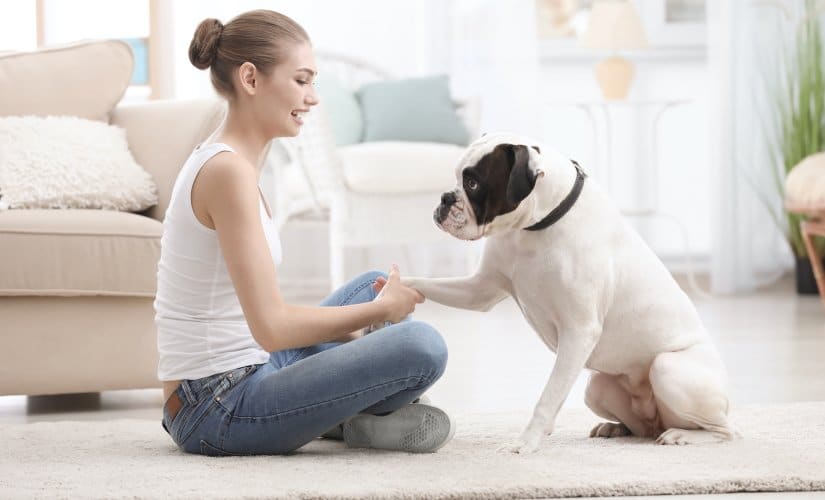Dogs, most especially puppies, can follow a command one day, and forget it completely the very next day. Whether you’re training your doggo in a basic obedience class, or at the dog park, your dog should learn the five basic commands: sit, stay, heel, come, and down. Creative dog training for dog tricks at home can be as simple as teaching your dog to sit or asking him to roll over which comes after teaching your dog the basic dog training commands.
Creative Dog Training for Dog Tricks at Home means understanding these commands and enhancing acceptable canine social behavior. Dog training for tricks also strengthens your bond with your dog. Nonetheless, repetitive training is sometimes difficult to do, and dogs do get bored with training.
Clicker Training for Dogs
Clicker training today is today’s positive dog training method. It’s very similar to the way words of praise are used, with the clicker and favorite treat used instead. Positive dog training is beneficial for all pups and doggos in that you’re harnessing your dog’s inattentive behavior and channeling his energy into specific training goals. The result will be a dog that’s a pleasure to have in your home, and one that’s easier to teach dog training trick to.
Dog Training Tricks for Fido
Creative dog training for dog tricks can be taught almost any time of day or evening, while you eat, watch TV, clean or even while you go swimming with your children. Here’s how:
- Pick up the dog toy and name it – “Ball.”
- Hold the toy where your furry best friend can see and reach it. When he looks at it, say “Ball”.
- Say yes and reward your pooch with plenty of praise and a treat.
- Repeat this a few times more until he starts putting the ball in his mouth at least 90 % of the time. If you want to use the clicker, say “Ball” and click, then reward him when he touches the toy with his mouth.
- Click and reward each time he touches the toy when you say, “Ball.”
- Now hide the toy in different places, naming it each time you place it somewhere.
- Your dog will soon touch it after you say ball, no matter where you place it.
If your dog enjoys playing fetch, have him fetch the ball when you ask for it by name. Remember to reward him for learning this new dog training trick with a treat!
Raising a Puppy
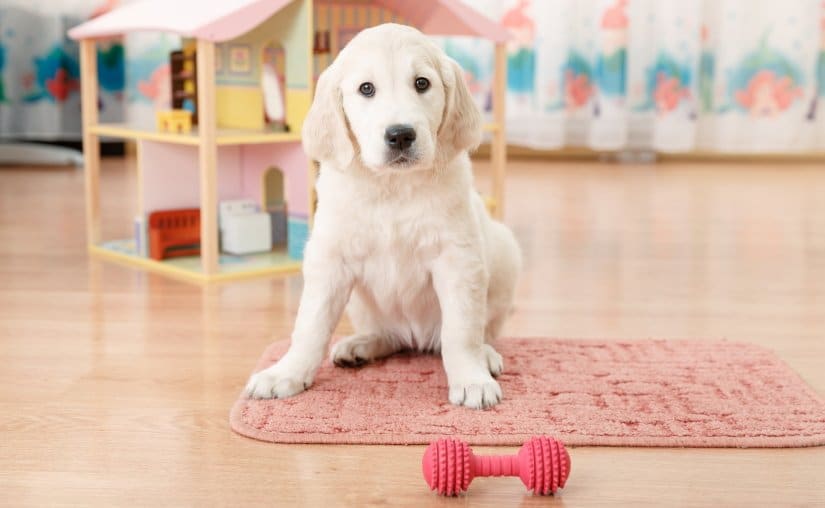
- All dog breeds and dog breed mixes are trainable, yet some breeds may be more difficult to train than others.
- Dog breeds that were bred to work alone as messengers and hunters are very independent dogs, and need a reason before they do something for you. Read up on your dog breed or dog breed mix before training.
- Some dog breeds only mature fully when they are two years old.
- Puppies need constant supervision and regular positive training.
- Some dog breeds are easily distracted because of their acute sense of hearing.
- Verbal corrections need to be gentle, since some breeds and breed mixes are very sensitive. All dogs respond well to praise and treats.
- Once your puppy settles down into a positive dog training routine, he will be your best friend.
- Your doggo is a natural problem solver and needs to be mentally stimulated every day. Make life the very best for your furry best friend.
- Some dog breeds may not be so friendly around other dogs in the beginning, but will slowly warm up. They may also not back away from fights, so beware of other aggressive dogs that may challenge your doggo. Also think one step ahead, to prevent a bad situation from happening.
Dog Training Secrets
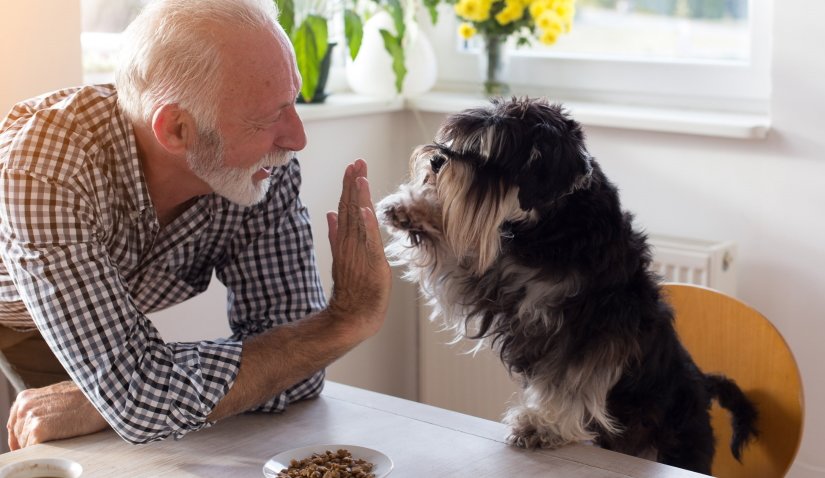
When using corrections with your dog, use only the gentlest correction possible. If you find that you’re not getting the results you want, find a professional trainer. If your dog is too busy having fun and not wanting to focus, put him in his crate for a short time or turn your back on him and ignore him for a few minutes. Remember to reward and praise when he does the required behavior.
Basic Obedience Exercises entails that before you teach new cues, you choose a release word, like “okay”. This tells him that he’s done with the exercise; otherwise he’ll sit and wait for the next cue. All dogs enjoy cheese bits and crumbled hamburger patties. Use these as rewards, but never overfeed or he’ll lose interest in the training.
You can start off by showing your pup how to do the exercise. If you know that he’s about to make a mistake, release him before he moves. Then end the exercise. Dogs will usually get it right after the third or fourth time, yet it will take him several days to fully understand what you want.
Dog parents think that teaching your dog to do tricks is pointless. With that said, being asked to “sit” is no different than being asked to “rollover for Fido. They’re both commands for your dog, and he’ll have fun learning new things.
When teaching your furry best friend a new trick, think about his physical characteristics, especially his size. Great Danes will have a hard time rolling over, and dogs that suffer from joint or hip problems should not be made to sit for long periods of time while you teach them to give you their paw.
Dog training tricks is just an extension of basic obedience training, yet much more fun for the whole family. Training your dog to do tricks allows for everyone to participate and strengthens the bond between family members.
- When teaching Jump for Joy, your dog needs to jump straight up, landing back in the same spot. Enthusiasm is key for this great trick, because no dog jumps for joy for no reason at all. You’re going to have to encourage him with treats.
- When your furry best friend is in a fun mood, hold his favorite dog toy above his head and tease him with it. You can also encourage him by jumping or running alongside him. Reward him right after the smallest jumps that he performs.
- When your dog eventually gets the gist of things and is jumping along with you, don’t jump as high. Crouch down and stand up all the while using the verbal cues and hand signal for jump. (Two thumbs up)
- Soon your dog will be able to jump for joy on command. Keep in mind that enthusiasm is key to this trick.
Dog Training Treats

Learning is hard work and all dogs need motivators. A motivator comes in different forms-a tasty food treat, clicker signal, praise or a favorite dog toy. Since food is enjoyed by all dogs, and is easy to dispense, it’s the most favorable motivator for dogs.
Keep your furry best friend motivated and keen to learn a new trick by using his favorite foods such as chicken strips, cubed hot dogs, cheese, hamburger bits and even fresh fruit and vegetable treats. When first teaching your dog a new trick, food treats are the best dog training motivators. Toys can become distracting and your dog will need to focus. Praise combined with dog training treats are best for rewarding the desired behavior.
Dog training for tricks, nonetheless is highly dependent on your furry best friend’s motivation. The activity has to be fun and enjoyable for him. If clicker training is used, then used the clicker signal to mark the correct behavior, and follow this with a healthy treat.
Instinct Dog Training
So often, prior to any training starting, your doggo needs to understand a few things like the sound of the clicker, eye contact, and treats that he gets for good behavior. He also needs to understand his name and “Come”. These are the essentials in good communication between you and your dog. Instinct dog training means that your dog is focused on you, and instinctively knows that you’re asking something of him. No dog can be trained if he is not focused and in tune with his handler.
Without eye contact, you won’t be able to teach your dog anything. Always wait for eye contact before you start a training session. Be ready to click and reward when using a clicker. Keep your focus on your dog to make sure that he’s watching you intently.
Place your hands behind your back in case he starts nudging you. When he does look up into your eyes, be ready to click and give him his long awaited for treat. Your dog will usually start focusing on you after three to ten seconds, and it usually takes three to four minutes for your dog to figure out that he should be looking up into your face.
Repeat this exercise for a few minutes each day for a week or two. Instinct dog training, if you haven’t already noticed, just seems to happen. Be sure to continue to reward your furry best friend with healthy dog training treats!
How to Teach Your Dog Down When Using Positive Dog Training?
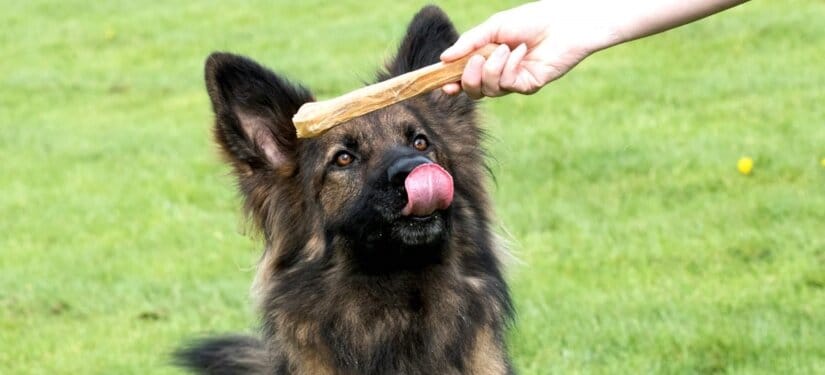
- Ask your doggo to sit and then you hold a treat on the floor between his paws.
- Move the treat away very slowly, and encourage your doggo to lower his elbows to the ground.
- When his front elbows reach the ground, praise him and reward him with the treat.
- Release him from the exercise.
- After he has done this a few times, try pulling the treat farther away until he lowers his hindquarters.
- Reward him again with a treat.
- When your doggo starts doing the down command reliably, add the verbal command and use less of your body language to show him.
- With that said, you need him to “Down” when you’re standing up. Once he grasps this exercise, reward him again.
How to Teach Your Dog to Kiss?
All dogs enjoy licking faces. This is a natural behavior that can easily be turned into a fun trick by saying “Give me a kiss” when your doggo does lick you on the face. When teaching your doggo how to give you a kiss, you’ll need to have plenty of rewards around, and to teach him to associate the reward with the kiss. In no time at all, your pup will link the two together, and you’ll have him responding with a big kiss.
Eskimo Kiss Trick With Doggo
Some dog breeds don’t enjoy licking hello, but prefer to touch noses. This is an easy trick to teach with the same technique, but saying “Eskimo Kiss” exactly at the moment that your doggo touches noses with you. When your pup has learnt this new trick, you can easily teach him the opposite, “No Kiss”. This is a good trick to teach your doggo when guests are around, and you want your doggo to be quiet.
If your doggo tries to lick you a big hello, you can walk away and say “No Kiss”. You will need to do this each time, so that your doggo learns that he has to have the okay to give you a kiss. Once you walk away, he’ll lose attention and focus on something else.
Choosing a Positive Dog Trainer for Your Doggo
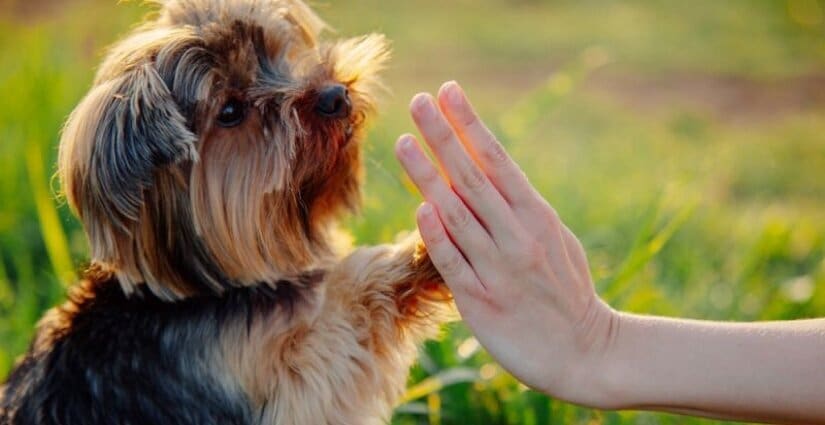
Positive dog trainers should be certified, and should have experience working with your type of breed. Inquire about the trainer’s experience and reputation. Some trainers don’t understand certain dog breeds.
Always inquire as to how the instructor deals with big and small dogs in dog training classes when they are together. How long has this trainer been dog training? Observe a class, and see if the dogs and students seem to enjoy it. Training puppies and adult dogs should be a fun and an enjoyable experience. If you don’t like the instructor’s methods, find another instructor.
Chewing and digging are all natural dog behaviors. So is barking. These are all ways that your puppy is going to express himself by. With that said, these canine activities often become problem behaviors that can make both human and dog unhappy.
Deal with all puppy training issues immediately before they become bad habits that are harder to break. Give your puppy enough physical exercise. This should be combined with positive training. Buy some canine puzzle games, play hide-and-seek, and keep your puppy mentally stimulated. A brisk walk around the block will not suffice to meet his needs.
Remember that positive puppy training and regular exercise are good for any dog breed. With newly rescued dogs that may be nervous, positive dog training may take a little longer. You will need to have plenty of patience and treats. If your rescue shows signs of nervousness, you will need to build up your dog’s confidence, and unlearn any bad habits that he may have picked up by replacing it with new behavior.
Each and every dog will have a few problem behaviors that will need to be addressed at some stage of his or her life. Keeping your furry best friend well-exercised and well-socialized is key to reducing problem behaviors together with working with a certified positive dog trainer.
